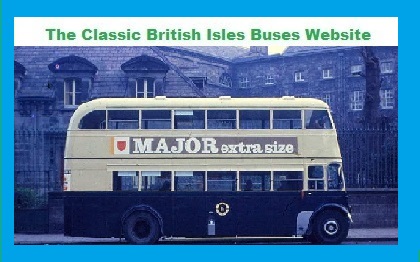

The Classic British Isles Buses website
The miscellaneous picture file (by Shane Conway)
(Part two: other buses and coaches, and tar tankers, fire engines, racing car transporters etc....)
Last updated on 19 August 2024
Email Classic U.K. Buses Classic Irish Buses Classic Manx Buses
| Page 1 | Page 2 |
Tim Robbins sent me these two views of his preserved Leyland PD2s, one each from the 1940s and 1950s.
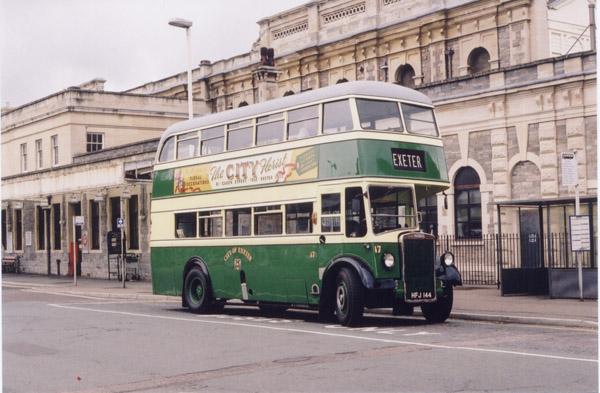
This 1948 Leyland bodied PD2 was new to City of Exeter, and is seen here outside Exeter St. David's railway station.
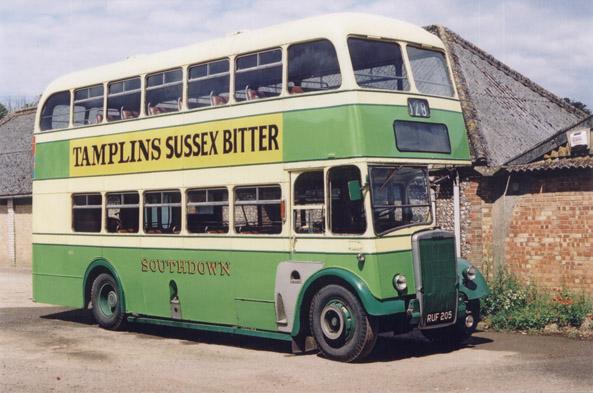
Tim's other bus is this East Lancs bodied PD2 in the ever pleasing apple green and cream Southdown livery. Another historic livery nicely revived after NBC privatisation, only to be lost again under Stagecoach stripes....
Onto the Leeds area this time in 1988, and a visit to the ever-interesting fleet of Black Prince of Morley, West Yorkshire.
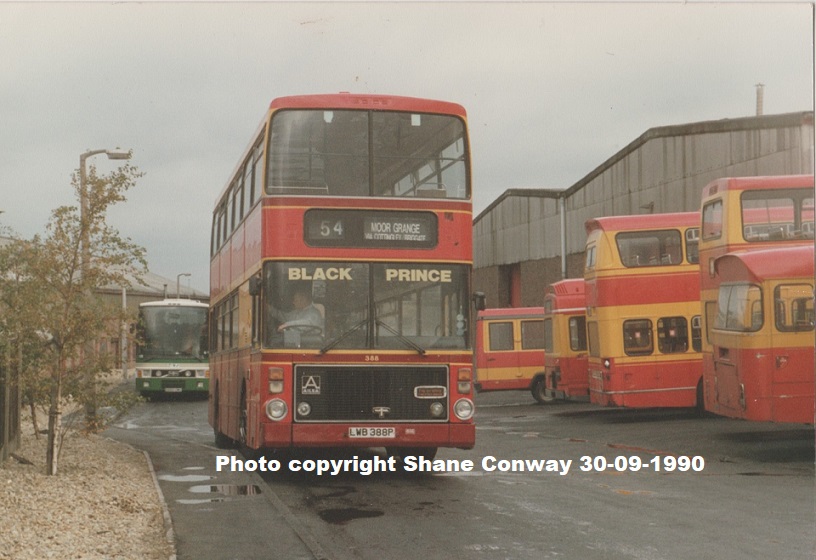
The main requirement was to photograph at least one of the operator's pair of ex South Yorkshire Van Hool McArdle bodied Volvo Ailsas, a vehicle type I had not previously laid eyes on. In the event I managed to snap both of them, as well as some more of the fleet.....
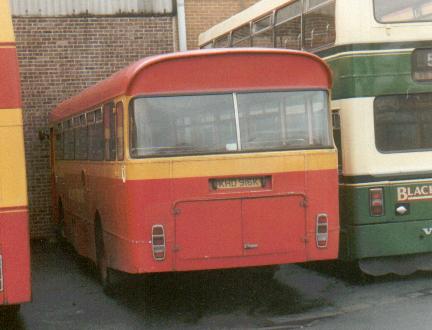
.....including this ex Yorkshire Woollen District Marshall bodied Leyland Leopard bus. At first glance a typical run-of-the-mill B. E. T Leopard bus, it belonged originally to a batch of vehicles registered KHD 912 - 924K, all bar two of which were bought by Lough Swilly in 1983 and 1984. This was one of the two that remained in England, the other being KHD 921K. To the right of 916 is the rear of the second Van Hool McArdle Ailsa (LWB 380P) which carried a commemorative livery for 21 years of Black Prince operation.
The Blackpool tramway centenary celebrations in 1985, on Sunday September 30th with most people going round in short sleeved shirts in the delayed heatwave!
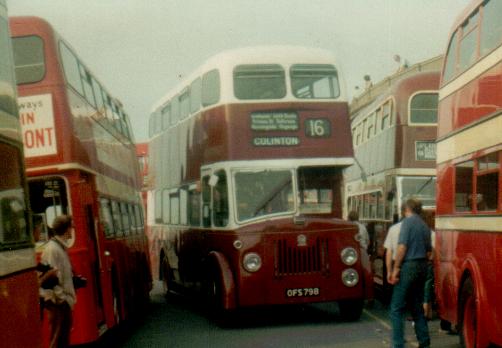
Here we see a selection of AECs and Leylands, pre-war and post-war, and from different areas. Centre stage is the 1957 Edinburgh Corporation PD2 (when new, these buses were denounced as monstrous masses of shivering tin, compared to the trams which they were replacing), which is gently easing out of its parking space.
To its left is Leicester AEC Renown CBC 921 (in a similar livery), and in front of that is a Ribble TD5, RN 8622. On the right of OFS 798 is an early Ribble (lowbridge?) Atlantean, with Halifax AEC Regent V LJX 215 just visible in front of the Atlantean. Finally, just visible in the V shaped gap between the PD2 and the PDR1 we can see a hint of a Routemaster, RM737 if I recall correctly.
Welsh and English municipal Leylands seen on visits to Ireland
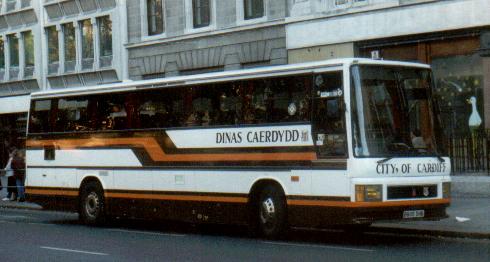
This City of Cardiff/Dinas Caerdydd Leyland Tiger coach with a Duple body (B905 DHB) was photographed in O'Connell Street, Dublin. The reason for its international journey wasn't known, but is a stark contrast to the days when municipal buses and coaches were rarely seen outside their respective town boundaries.
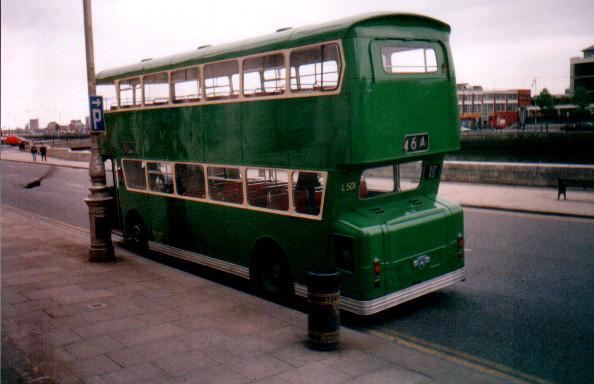
Preserved ex Liverpool Leyland Atlantean L501 was pictured at Custom House Quay in Dublin in the summer of 2000, during a week long tour of Ireland by members of the Merseyside Transport Trust. The Atlantean was used to recreate the 1964 scene when similar bus L695 was on demonstration to CIE on route 46A to Dun Laoghaire. L501 was ably driven by Geoff O'Brien through the south Dublin suburbs with yours truly as a navigator.
Scottish GUY Warrior LUF
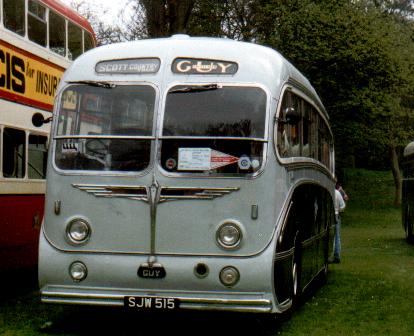
SJW 515 is a rare 1956 Guy Warrior LUF / Burlingham Seagull C41F, originally a Guy demonstrator, passing to Dodds Coaches of Troon in 1957, and remained with them for 40 years. Dodds dated back to 1910, ran tours over most of south/mid Scotland, and also held a few licences for stage carriage services from Troon, none of which operated to a fixed timetable! The coach was photographed at the I.T.T. Bangor rally in 1989, and an edited version of this photo was later used on the cover of a Judie Tzuke CD.
In 1997 Stagecoach took over Dodds and this coach came with the package, becoming part of the Stagecoach collection of historic vehicles, based in Scotland. It was restored and repainted in Bluebird livery (cream sides, with blue roof/front/back, whereas it had worn green sides with cream roof/front/ back when with Dodds), and went back into service later the same year on regional tours (Glories of Perthshire) from Edinburgh. The drivers wore full Highland dress, and one of them even played the bagpipes to passengers. (Information courtesy of Dick Gilbert).
Portuguese AEC Regal
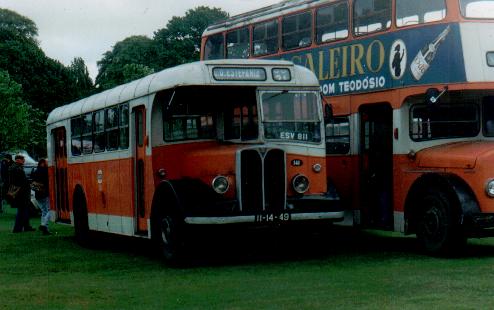
Photographed at the 1993 AEC Rally in Nottingham was this unusual looking left hand drive AEC Regal III, which originally saw service in the Portuguese city of Lisbon, with municipal operator CARRIS. AEC at one time had quite a large export market which presumably made it worthwhile to produce buses the wrong way round. Alongside can be seen a Regent V from the same fleet.
From Derek Thompson comes this delightful contribution.
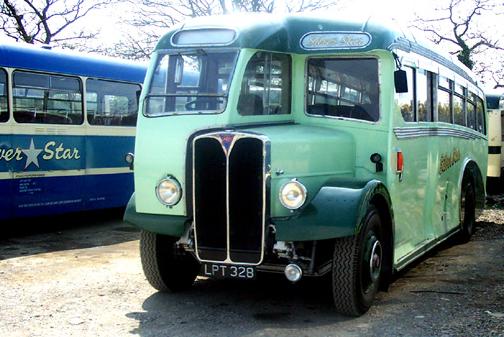
LPT 328: Operated by Silver Star Coaches of Caernarfon, Gwynedd.
An unusual addition to the Silver Star Coaches fleet is LPT 328, a 1950 AEC Regal III with a Burlingham C33F body. This coach is used by the company to operate their nostalgic half and full day tours, and is available for private hire. The coach was new in 1950 to Gillet Brothers in County Durham.
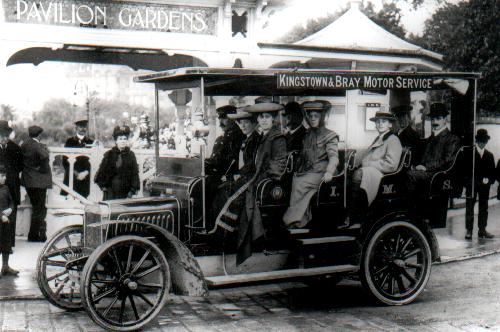
Now, this vehicle or its operator I know very little about. Kingstown is now called Dun Laoghaire, so presumably this was a very early bus service between the two towns mentioned on the roof board sign. (Photo by Robert Grieves).
Further information has come from "JackMcC" as follows:
Regarding the photo of the Kingstown & Bray Motor Service bus taken in front of the old Kingstown Pavilion, I would like to shed a (very) little light. The Kingstown to Bray service was originally operated by John Quin (of the Royal Hotel in Bray, the Quin of Quinsboro Road, Bray) with a horse bus provided to him by the Dublin & Kingstown Railway. Obviously this was to encourage passengers going through to Bray to use the train as far as Kingstown prior to the railway being extended from Bray back to Kingstown which wasn't finalised until 1856. The D. and K. R. also gave some financial support to one John Pemberton who operated on the same route.
This reference comes from the late and very much lamented Kevin Murray's book Ireland's First Railway (I. R. R. S. Dublin 1981). At what stage the route was formalised as the Kingstown & Bray Motor Service and who was the owner when the photo was taken I don't know.
Can anyone identify the make of vehicle, or when the photo was taken?
Bus based trucks
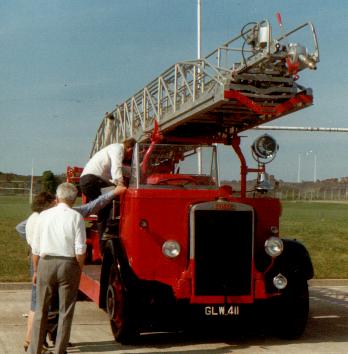
This unusual looking machine is a Leyland Titan, thought to be of the TD7 variety, being one of 30 which were never built as buses. Instead the 30 chassis were used as the basis of an order for London Fire Brigade during the war years, and registered GLW 410 - 439.
This one is understood to have subsequently served in Glasgow, and was later swapped for a 1928 Albion which was in use in Galway. The Albion is now in Glasgow Museum of Transport, and the Titan was acquired by Irish preservationists in the early 1990s and appeared at a few rallies. Any further information on these vehicles would be welcome.
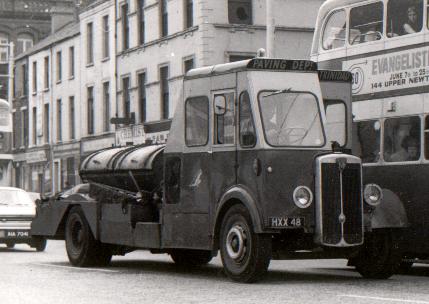
This one time coach, new around 1946, was in use as a tar tanker in the Belfast area by the late 1960s. The owner's name was Limmer and Trinidad, part of which can be seen above the nearside front window. The vehicle itself is a Maudslay Marathon III, of which very few were ever used in Ireland. (Photo by R. H. G. Simpson)
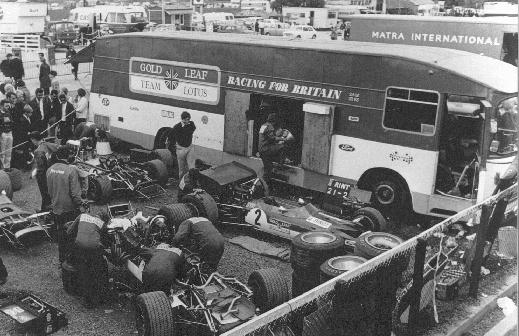
This is a 1967 AEC Swift based car transporter, LVF 480E. Its current owner, Joe Willenpart, sent two photos, the first taken in 1969 (above), the second (below) in 2003. Based on chassis number MP3R071, it was bodied by Norwich Coachworks and first registered on May 8th 1967. Initially it was in use by the Gold Leaf Team Lotus during its Formula 1 World Championship winning years of 1968 (Hill) and 1970 (Rindt).
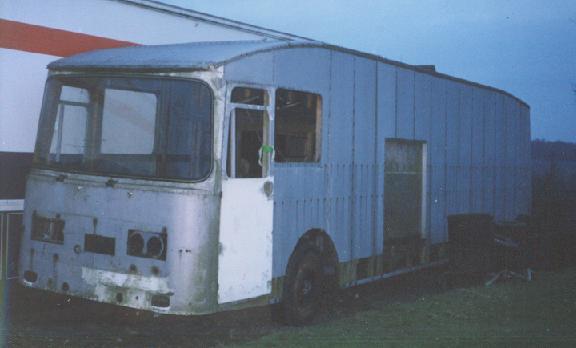
On our London 1986/87 visit photo gallery on the former Fotopic site, there was a photo taken of Bedford VAS5 JJM 901H with Putt Coaches in Wimbledon. Ken Bridges e-mailed me in February 2006, as follows:
"I was trying to find some information/pictures on a type of coach I used to own some 11/12 years ago, and I just typed the registration in just on an off chance. I was staggered to find a picture of the very coach in care of its previous owners to me on your website. I have to say it looks better in your picture than it did when I got hold of it. I rescued it from a salvage yard in Luton, where it had ended up after a very bad smash in the rear. Fortunately no-one had been hurt, but the coach was a write off as far as passenger travel was concerned. I know you will cringe when I tell you I bought it for the sole purpose of carrying my race car around, a fate that no doubt befalls many old coaches. After a six month rebuild she passed her test and I used her for around five years and covered many thousands of miles in her. The only let down was a blown tyre on what is now the A14 near Cambridge. Eventually spiralling insurance costs of the time led me to sell her on. The new owner sadly only kept her for a year before deciding to break her for spares and I think most of the mechanicals went abroad." Regards, Ken Bridges
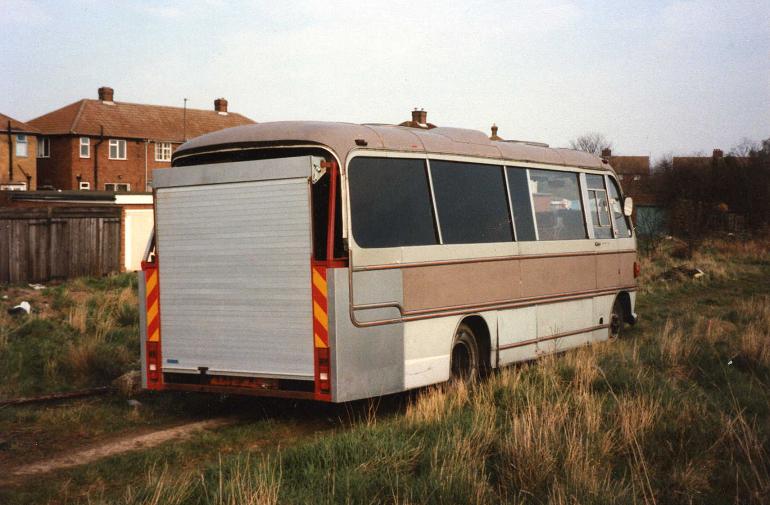
East Kent AEC contrasts
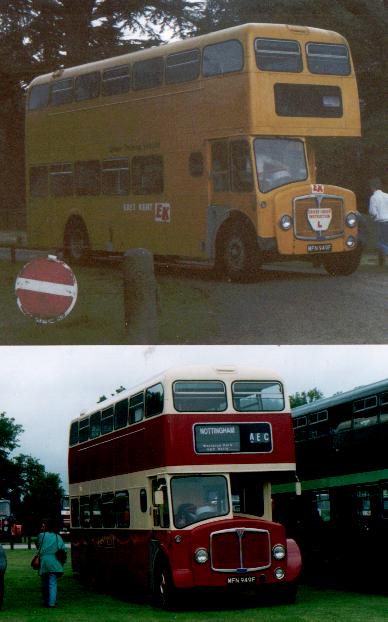
Preserved ex East Kent AEC Regent V MFN 949F was photographed at the 1993 AEC rally in Nottingham, beautifully restored in that deep maroon and cream livery. The upper picture depicts the same bus five years earlier attending Showbus at Woburn Abbey, it then being in use as a driver-training vehicle. Even though the photos are not the greatest, it's an interesting contrast.
Single deck Leyland Atlantean
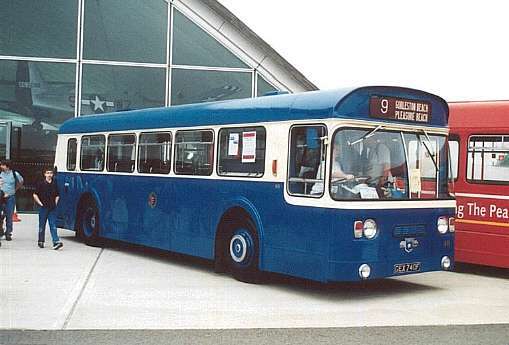
GEX 740F is one of a small number of Leyland Atlanteans built as single deckers, as opposed to those unfortunate vehicles which ended up fighting a losing battle with low bridges! This Marshall bodied bus, and sisters GEX 741/42F were new to Great Yarmouth, while Portsmouth Corporation had ten others new in 1972. Photo by Dick Gilbert.
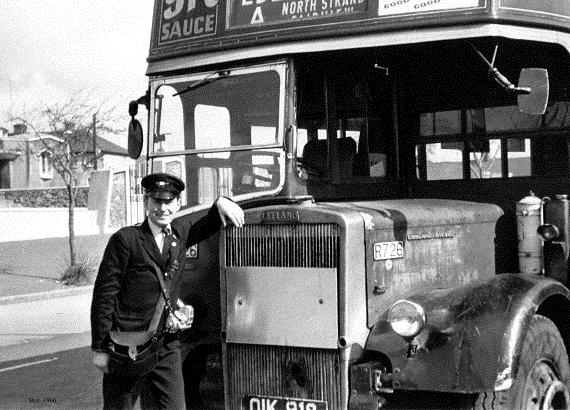
For many people (me included), the vehicle depicted in the above photo is THE classic Irish double decker. R726 is a 1957 CIE bodied Leyland Titan OPD2, taken on the Howth Road opposite Raheny church in 1966, at the then terminus of route 29. When this photo was taken, I was just three years old, and lived within a mile of the very spot where the picture was taken, so these type of vehicles kick-started the whole mad world of bus enthusiasm for me, almost 60 years ago now. R726 had been transferred to Clontarf in 1965, and as can be seen was badly in need of a repaint from its original green livery to the then new blue and cream, by this time green buses were becoming a rarity in the CIE fleet. The ticket machine is a TIM dial type (which remained in CIE use until the 1980s), and the photo was sent by Ben Sadler, the conductor in the picture.
He writes:
"I worked as a bus conductor at Clontarf garage from 1966 to 1968. After initial training you were used as a general cover for the first year of your service after which you were allocated a rotating roster paired with the same driver. I worked on the 20 (Donnycarney), 20A (Donnycarney North), 27/27A (Coolock and Artane), 28 (Edenmore), 30 (Dollymount), 31 (Howth), 32 (Portmarnock), 42 (Malahide), 44A (Mount Prospect Avenue), 51A (Beaumount), 54 (Killester to Cherryfield Drive) and 88 (Hill of Howth) routes in the first year.
There was also a duty system called universals which usually entailed working for some hours, having a very long unpaid break (sometimes 3 or 4 hours) and returning for the remainder of your shift, this would encompass a number of routes. One turn on one of the universals involved entering the docks at the North Wall to collect dockworkers, your bus would be full and standing but if you got 10% of the fares it would be rare. You would walk through the bus and the majority would totally ignore requests for fares. Inspectors never got on to check tickets. Another universal had as part of its duties going to Cadbury's factory in Coolock where we were allowed to purchase loose chocolate sweets at staff rates. Just imagine maybe five pounds of chocolates which was often added to by Cadbury workers when they got on the bus.
Sometimes other garages would have staff shortages and you would be loaned to them by the day, I did a number of turns out of Ringsend on routes to places I had never been to before. After this first year I rarely worked anything except the 29/29A (Raheny), 31 or 88. I worked the 51A Beaumont on Christmas Day 1966.
There were different TIM machines in use at different garages, the ones at Clontarf were very simple ones made by Plessey I believe, whereas those at Summerhill and some other garages had small windows with running totals, these machines were put in a cradle and the windows photographed at end of shift. The cashbag was supplied new and was very stiff and hard on the fingers, and the uniforms were made by a tailors who would offer to fit extra hidden pockets etc for a fee.
The Malahide route was unusual as you started in an urban area and about ten miles out from the city it was like stepping back years with people getting on (infrequently) with sacks of potatoes etc. and plonking them under the stairs, there were some lovely old characters. When free travel for pensioners was introduced claimants had only to show a pension book. At Donnycarney North sometimes about 0900 it was not unusual for 20 or more pensioners to board at once, some of them can hardly have been 40. On the Beaumont route there was an older lady who wore a Nazi badge on her coat; she had apparently worked for the German ambassador before or during the war.
The fare from Howth to City Centre was 2 shillings and sixpence and from Sutton 2 shillings. A conductor was obliged to give change for whatever note was tendered and no excuses would be entertained by inspectors for not issuing a ticket. I remember on one occasion being tendered £10 (which would be an average take home weekly wage) for a 2 shilling fare and having to go into a pub to change it.
I also did a spell on the Hill of Howth single-decker service (88) which carried very few passengers. It was very pleasant going up the hill in the summer. The messing arrangements were as far as I can remember to take a rest etc. in the signalbox at Sutton. Sometimes you would only take £1 or so on a complete shift. An overtime turn was to run specials from the dancehall at Portmarnock to the City centre in the early hours on Sundays.
I remember how busy it was at Easter 1966 for the 50th anniversary of the uprising. I was walking down Talbot Street in the early hours of the morning when Nelson got blown up. In 1968 I lodged with a family in Raheny called Brennan. (A bus driver from Clontarf who was nicknamed Wo - Wo because he would always hold the bus on the clutch and handbrake while revving the engine, making the bus creep even as people were getting on, it made for a long stressful day working with him.)
The R types were pleasant to work as they were relatively steady, but not RAs, R900s or Atlanteans as they seemed to lurch and roll more and as you would be walking through the bus or going up or down stairs with a bag and ticket machine you got bounced about sometimes.
CIE had a canteen behind Clery's store which was also well frequented by the Guards (police) who did traffic duty in the city centre. We would change crews in Abbey St. or Eden Quay etc. to go for meals. I remember an item on the news of an Atlantean apparently losing its steering and crashing into the steps of the Bank of Ireland. There was very little trouble back then from youths etc."
The Atlantean referred to above was D45 of Ringsend garage, which collided with the steps on March 5th 1968, and remained out of service for over a year. My thanks to Ben for sharing those memories with us.
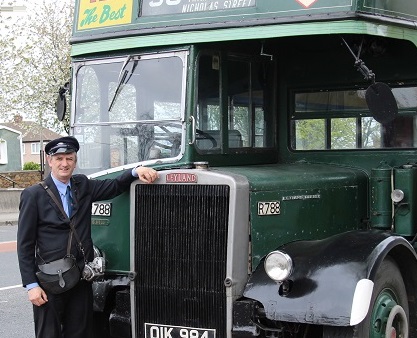
As a postscript to Ben's picture, 47 years later (May 2013) preserved R788 was posed at the same location as R726, with driver Des Willis taking on the conductor's role. Photo copyright Kevin Horgan.
December 2010: Sean Foley of Castlebar, Co. Mayo e-mailed me to say:
"My father was a GNR/CIE bus driver based in Sligo. He started with the GNR in 1944 and retired from CIE in the 1960s. We lived in North Sligo (along the main Sligo Bundoran road between the villages of Grange and Cliffoney) and I want to give you a bit of an insight into a GNR bus registered ZA 2726 and how it ended up following its retirement. I was born in 1950, and when I was about 4 years old or so that bus made its last trip to our house. Pending its arrival we had two parallel walls built on which the bus was placed after the chassis was removed. On the day it arrived, quite a few men were there to help and they rolled the bus along the walls on rollers later, of course, removed. Insofar as I can recall, the chassis part was driven away but I may be wrong. I'm not so sure that we ever used the bus for much storage etc but I recall us and neighbouring children had wonderful times in it playing our games and running crazy up and down. Also, by the time it came to our house the seats were removed. The ceiling was made from tongued and grooved sheeted timber, painted white (but cream by the time we got it!) while the sliding windows were made on solid brass chronium plated. All the time we had it, ZA 2726 was to be seen on the back written inside a sheet of glass in white lettering against a black background."
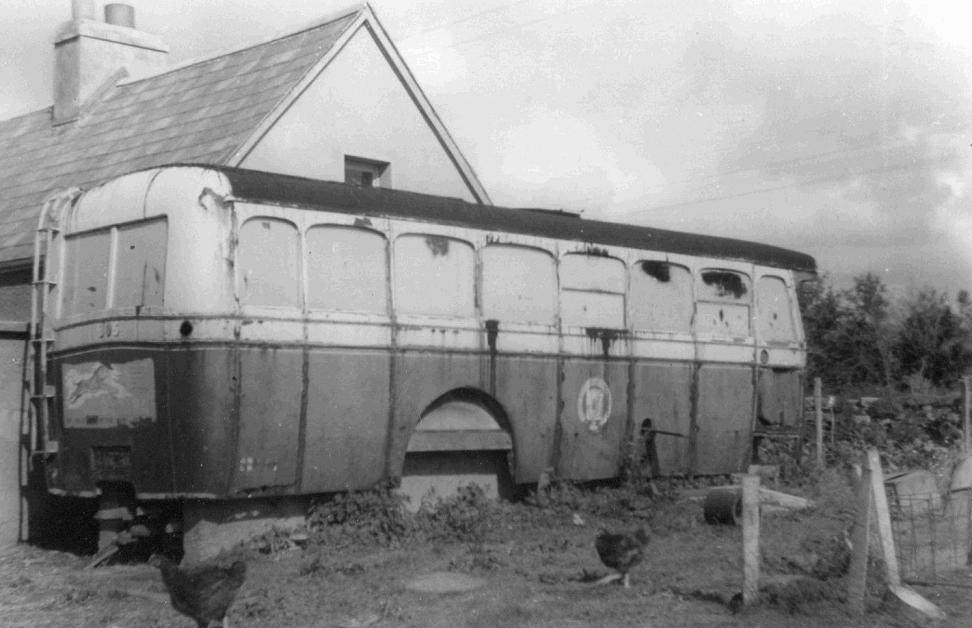
This bus was a 1935 Leyland Lion, fleet number 305, withdrawn in 1953. Photo taken at the Foley house, copyright Robert Grieves. I then e-mailed the photo to Sean Foley, and in turn received this reply.
"Shane, I am truly gobsmacked! That is it in the form we had it, taken at the side of our house. I cannot believe that it should come to me the way it did given we dont have a single photo of it anywhere. Obviously it was taken by somebody who had an interest in buses, public transport archives and all of that. It is truly remarkable that I had the number of that bus hardwired into my head, sifted though the registration numbers on your site, found it and contacted you and that you could come back to me with a photo of it taken at our very house. See the chickens running about, that was very much part and parcel of rural life and self sufficiency in 1950s Ireland. The bus looks so shabby in the photo but in a special way it was much admired at the time and was a great landmark. Yes that cab was cut away and I recall there was a rusty steel bulkhead exposed to the front after the cab and chassis went off. My oh my, what memories it brings back to me and almost brought a tear to my eye thinking of my deceased parents, brother etc.
That bus was scrapped by us in about 1962/63. As things moved on and people started to get that little bit more sophisticated (or so they thought), my mother didn't want it there any more and so it had to go. Certainly looking at it now and placing it in 1960s Ireland I suppose I couldn't blame her.
I grew up in the 1950s and 60s with two double deck buses based in Sligo and Ballyshannon. About 1965 the last one (CIE R796) was withdrawn because of the risk of it toppling over in cross winds that road is exposed to given that to a large extent it runs along the coast. Another bus that I held in great affection was the AEC Regal Mk IV and I think they came over from GNR to CIE. As I recall they had a fleet prefix of AU. They had a flush front and the driver (sometimes my dad) was fully cubicled off from passengers and conductor. They had a glass hatch type door that could be opened from either side. They had a pre-select gearbox where, as you will know, the gear didn't engage until clutched. As a small boy I travelled to Sligo within the cab with my dad. I still recall the pattern of velour on the seats and I think it was that bus too that had circular and rotatable ashtrays which were stamped GNR(I). I also want to mention that I recall in the late 1950s/early 1960s my dad and indeed other GNR/CIE drivers doing pilgrimages from Donegal Town, Ballyshannon and Bundoran to Knock Shrine. When the bus got to our home it was full with passengers standing. The driver/conductor called to our house for a few chairs and we didn't have a chair to sit on until the bus came back in the late evening.
Earlier this year I visited the Transport Museum in Howth. I took a keen interest in (CIE Leyland Tiger) P347. I noted that car as the drivers referred to them in those days was for a time based in Sligo/Ballina and ran between the two towns. Undoubtedly, my dad would have driven it at some stage because he worked that route periodically. As per the museum information, P347 ran later between Westport and Louisburgh - by then it might have been in semi-retirement. I don't want to take up any more of your time but I am truly amazed of how all of this came about.
You have made a tremendous contribution to archiving so much about public transport in Ireland and I note beyond Ireland too. I congratulate and compliment you for same. I must delve deeper into your site - it is a treasure trove for those who have a keen interest in transport in all its forms of times past."
April 1973 saw the bus fleet of Belfast Corporation pass to the newly formed Citybus Services, a sister organisation to Ulsterbus Ltd. 350 buses were transferred, and as might be expected both companies would follow a common fleet policy, Citybus getting a large fleet of Alexander bodied Bristol RELL6Gs from 1975 onwards, built to a standee dual door specification. The ongoing losses to the bus fleet from terrorist activities led to the purchase of secondhand vehicles from English operators, with around 200 ex London Transport AEC Swifts and Merlins in the late 1970s, and these were followed by ex National Bus Company ECW bodied RELLs from 1981 onwards.
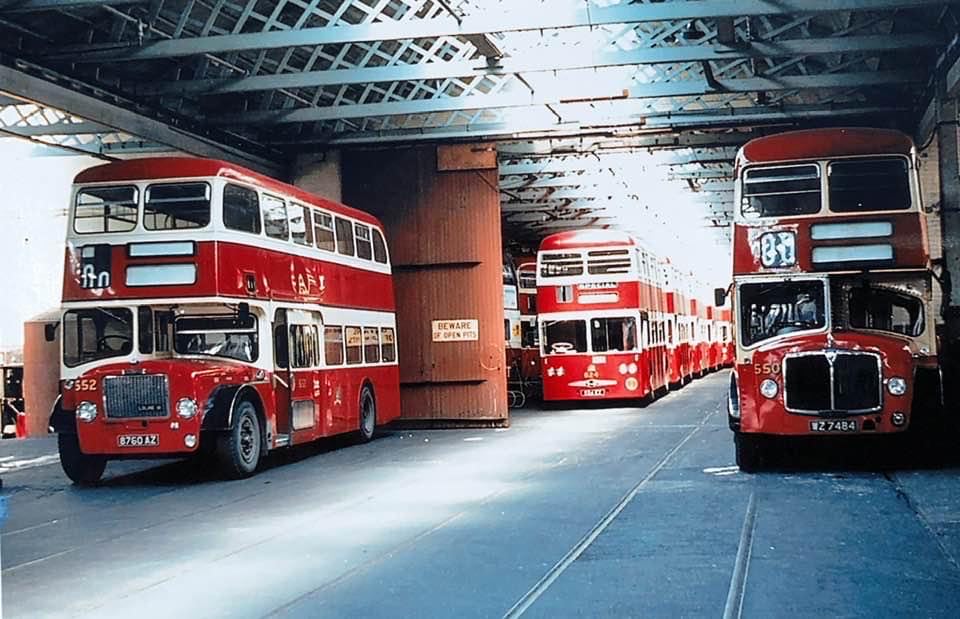
Belfast Dennis Loline 552 in Falls Park in 1963, with AEC Bridgemaster 550 on the right of the photo. As well as a line of new Fleetlines, Atlantean 551 is also just visible behind the doors of the depot building.
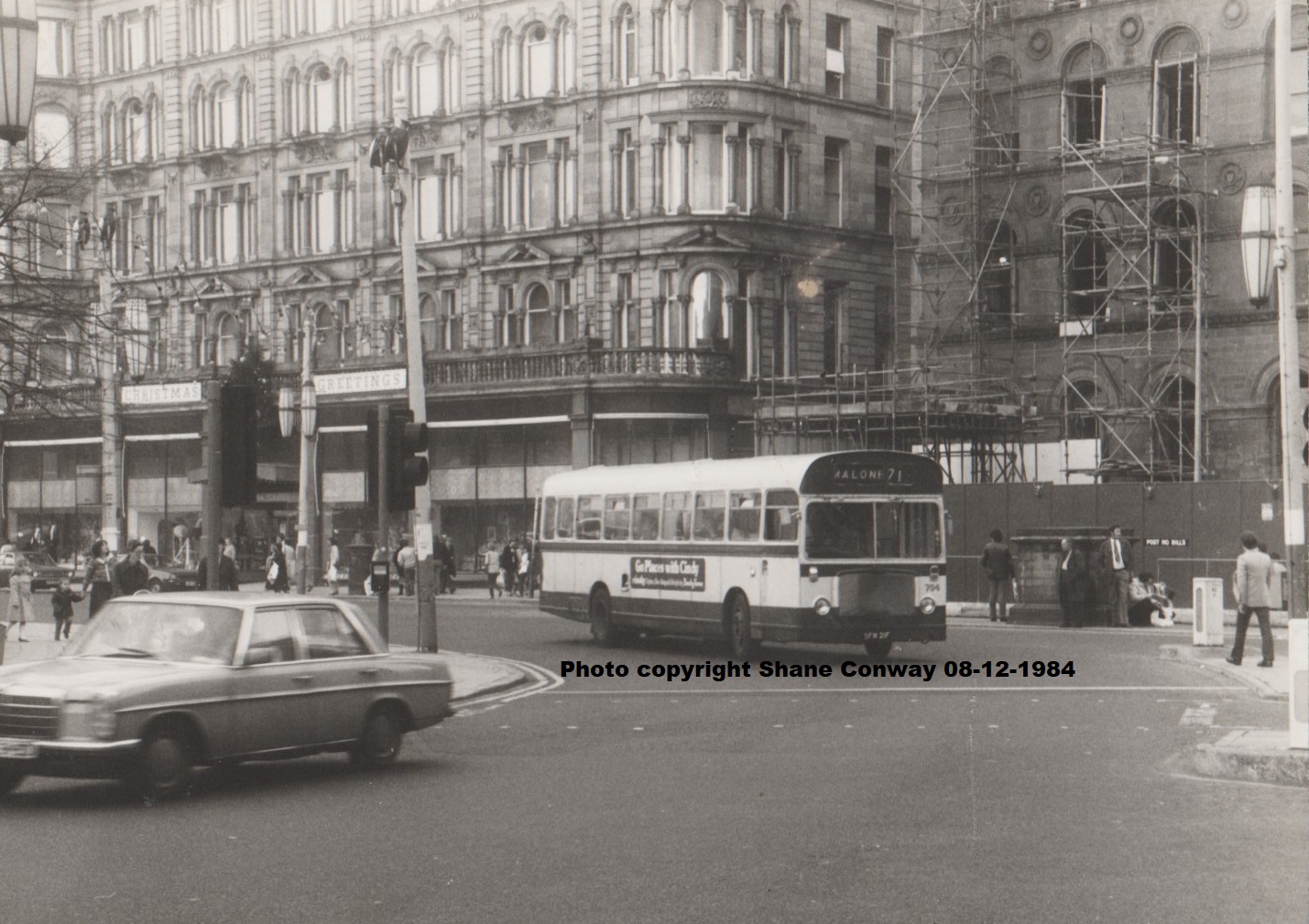
21 years later, on 8th December 1984, ex Crosville RE 704 is seen in the centre of Belfast on route 71 to Malone Road. Close on 200 RELLs were acquired secondhand and they proved to be a much more reliable purchase than the ex London AECs had been.
Preserved ex Ulsterbus 1983 Bristol RELL6G/Alexander (Belfast) BXI 2599, which lives in Nottingham nowadays, made a return visit to Northern Ireland in July 2023. Part of its itinerary was a photo-shoot in Coleraine depot posed alongside the current Translink bus with the same fleet number. BYZ 299 is a B40F Wright Streetdeck, new in June 2022, and the paired picture shows just how far vehicle design has changed in four decades. Given a choice, I know which 2599 I would prefer!! Thanks to Paul Waplington (owner of the RELL) for sending this interesting photo.
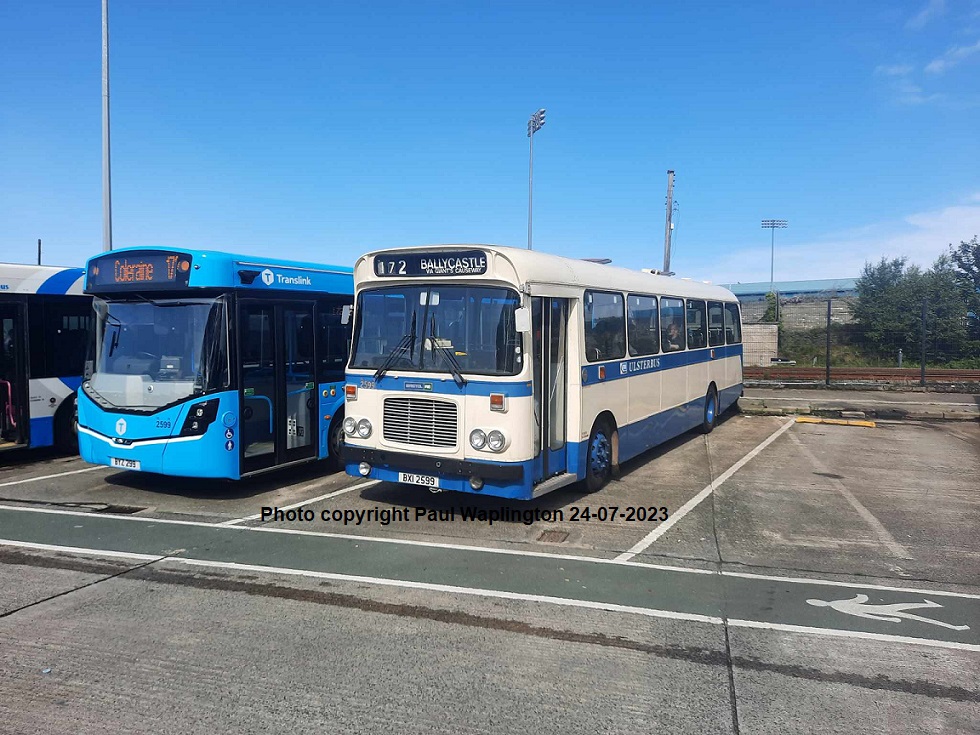
Email Classic U.K. Buses Classic Irish Buses Classic Manx Buses